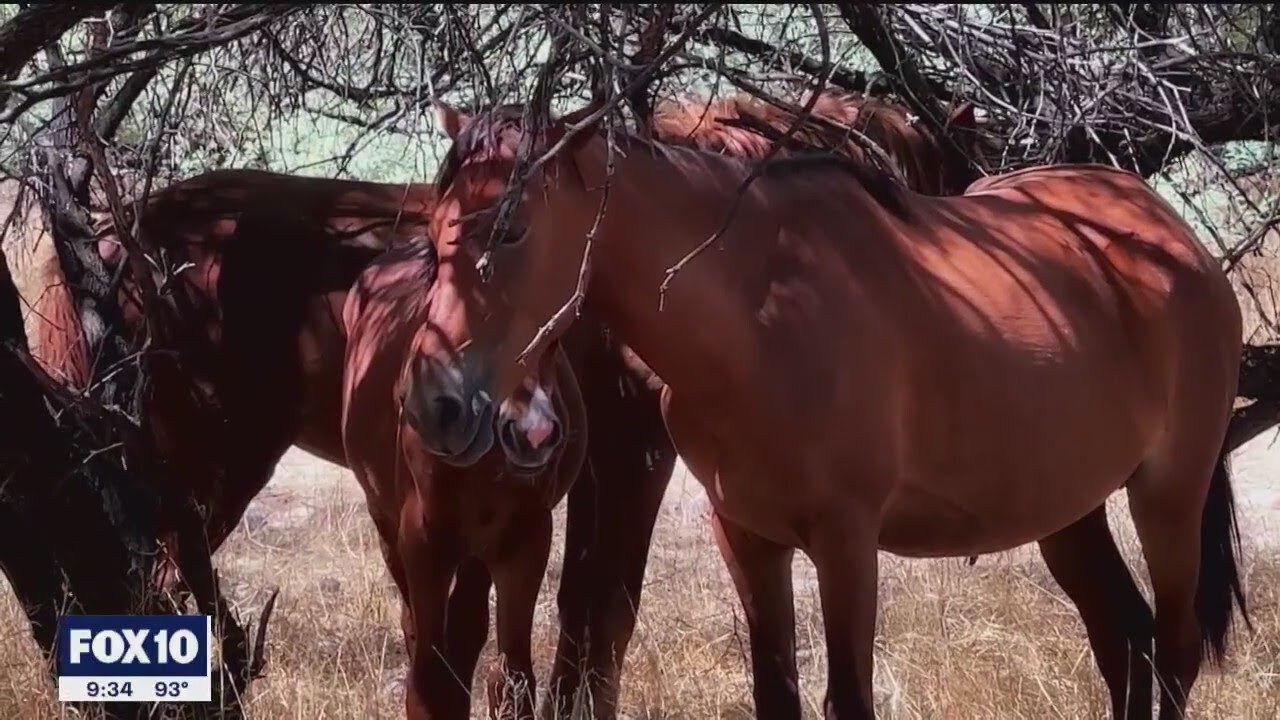
FOX 10 Phoenix: Arizona forest refuses offer from group to help control wild horse population. Here’s the reason why
FOX 10 Phoenix: Arizona forest refuses offer from group to help control wild horse population. Here’s the reason why
By Stephanie Bennett | Published September 26, 2023 9:52PM | Updated September 27, 2023 10:16AM Special Reports | FOX 10 Phoenix
PHOENIX – It’s a war over wild horses: whether they can continue to roam freely or be auctioned to anyone who will buy them, including overseas slaughterhouses.
A local non-profit has worked for years to maintain their horse populations, and now, after its success, their eyes are turning towards helping other parts of the state before it’s too late.
The horses are part of the natural beauty of the Salt River, and people from across the world come out every single year, hoping to catch a glimpse of them. Their lives, however, could have been much different if it wasn’t for these guys.
“I see people from all over the world,” said volunteer Rick Blandford. “Ladies come in, It’s a lifetime dream. They start crying when they see them. It’s pretty impressive,” said Rick Blanford.
Simone Netherlands took us on a paddling trip along the Lower Salt River, looking for the wild horses. Netherlands has made it her life’s work to care for and protect these wildhorses.
“We have 313 Salt River Wild Horses, and we have them all logged in a database, so we know each and every one of them,” said Netherlands. “These horses are so important, because they are a historic remnant of our old pioneering days in Arizona, and people love to see them on the river. We’ve done DNA research on them. They came here originally with the Spanish explorers who came through this area.”
Protecting these horses wasn’t easy. Netherlands started the Salt River Horse Management Group in 2014.
“Back then, we presented the proposal to the Forest Service,” Netherlands recounted. “Instead of removing them, let’s manage them humanely, so that the public can enjoy them for centuries to come. We are very happy that they gave us the chance to manage these horses humanely because through that program, we have already actually prevented 500 horses from being born, and just calculate how much money that has already saved the government.”
Program involves birth control
AZ nonprofit working to maintain wild horse herd, but some are refusing their help
There’s a war of sorts over wild horses in Arizona, and whether they can continue to roam freely, or be auctioned off. While a non-profit has worked for years to maintain the wild horse population, officials with a national forest in Arizona are rejecting their offer to help with the forests’ wild horse population.
There’s a war of sorts over wild horses in Arizona, and whether they can continue to roam freely, or be auction off. While a non-profit has worked for years to maintain the wild horse population, officials with a national forest in Arizona are rejecting their offer to help with the forests’ wild horse population. FOX 10’s Stephanie Bennett reports.
Netherlands’ idea to control the population of horses involves darting the mares with birth control, once a year. The group does not charge the Forest Service anything, as the nonprofit is supported solely by public donations and volunteers.
The plan appears to be working. In 2019, more than 100 foals were born, but thanks to the group’s efforts, only 16 were born in 2020. That number fell to two in 2021 and one in 2022.
So far in 2023, two foals were born.
The group tracks all the horses’ whereabouts on an app. Blandford tracks the horses every day.
“I started with photography, and then after I started photographing the horses, I started thinking ‘Well, I need to do something to help them,’” said Blandford.
Another volunteer, Steve Nurney, helps the group with all their programs, from fixing broken fences so horses don’t wander onto the roads, to patrolling the area, darting mares, and rescuing injured horses.
“To think that you’re 20 miles from Downtown Phoenix, and you see such – first of all, such a beautiful place, and then you see all these beautiful wild animals, it really is – it’s a throwback to the Old West. It’s really quite amazing.”
National forest rejects offer from group
Netherlands says they’re the only organization in Arizona that manages wild horses humanely, and her eyes are now set on expanding and helping others.
“The Apache-Sitgreaves Forest Service decided that in Alpine, they should remove all of the wild horses, and it’s very, very sad because if they were to just use birth control to prevent them from growing too fast, then the public could still see those horses,” said Netherlands.
A spokesperson for the Apache-Sitgreaves National Forest in northern Arizona told us that they have between 300 to 500 horses remaining on the Alpine and Springerville Ranger Districts. The forests’ goal is to remove them all. They claim the horses are ‘humanely gathered at trap sites,’ and then auctioned to the public.
“The auctions that they go to are auctions without limitation to slaughter,” said Netherlands. “For them to end up in a slaughterhouse versus the beautiful, idyllic lives they led is just an atrocity, and we cannot stand that happening to wild horses, and neither can the public. It’s just simply not what the public wants,” said Netherlands.
In June, Netherlands and her team quickly raised the funds to rescue 70 alpine wild horses from auction. Netherlands says she’s tried to convince the forest to let her humanely dart the horses free of charge, but to no avail. Forest officials say ‘management’ of the ‘unauthorized horses’ is “not an option allowable by Federal law for the Apache-Sitgreaves National Forests.”
“Just imagine. These horses will continue to breed, and then they will have to continue to round them up every year, and that actually costs them, so far, over $2 million to remove 350 horses,” said Netherlands.
Why are Apache-Sitgreaves National Forest officials rejecting the offer?
In a statement, forest officials said “these feral horses are causing excessive damage to forest resources, including harmful effects to the habitats of Federally threatened and endangered species in the area, as well as out-competing native inhabitants” of the forest.
Forest officials also said, in the statement, that the drought has worsened the aforementioned issues, and that ‘the decision for removal is a “necessary step” to ensure that the forest is “healthy and sustainable for year to come.”
For now, Netherlands says her fight is only just beginning.
“Why not control their population humanely, so that the public can still see them, so that it doesn’t cost the taxpayer a ton of money, and so the horses can be happy here, where they belong, where they’ve lived for centuries?” Netherlands said.
View the original article on Fox 10 Phoenix:
Arizona forest refuses offer from group to help control wild horse population. Here’s the reason why
An Arizona group has had some success in controlling the Salt River Wild Horse population, but as they set their sights on wild horses in other parts of Arizona, some officials are refusing the group’s offer.
